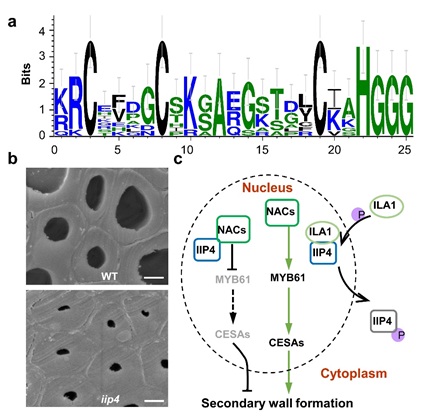Secondary cell wall (SCW) is the most abundant renewable natural resources on earth. Because cell wall polymers can be used as raw materials to produce daily necessities and biofuel, their economic value can extend to human health as well as industrial and energy production.
SCW also plays structural role in various physiological processes of plant growth. SCW biosynthesis is therefore under a tight control. A number of NAC and MYB transcriptional factors constitute regulatory network to orchestrate SCW formation in responses to various in vivo and environmental stimuli. However, very few repressors have been identified.
ILA1 Interacting Protein4 (IIP4) is a phosphorylated substrate of ILA1, a previously reported Raf-like MAPKKK regulating the formation of SCW in rice.
As IIP4 is an uncharacterized protein, the ILA1-IIP4 mediated signal transduction pathway and its related function remains elusive.
The group of Prof. ZHOU Yihua from the Institute of Genetics and Developmental Biology, Chinese Academy of Sciences, recently reported that an uncanonical CCCH-tandem zinc finger protein IIP4 negatively regulates secondary synthesis, and its repressive effect is attenuated by translocating IIP4 from the nucleus to the cytoplasm through phosphorylation.
To reveal the regulatory pathway IIP4 involves, they generated iip4 mutants using CRISPR/Cas9 approach. Biochemical analyses revealed that IIP4 interacts with NAC29/NAC31, the higher-level regulators of secondary wall synthesis, and suppresses the expression of the down-stream targeting genes, such as MYB61, CESA4, CESA7, and CESA9, leading to compromised SCW formation.
ILA1 mediated phosphorylation on IIP4 alters its subcellular localization. Phosphomimic IIP4 proteins translocate from the nucleus to the cytoplasm, which releases interacting NACs and attenuates the repression function. SCW formation is thereby promoted.
Sequence alignment found a regular tandem repeats of unreported CCCH motifs (C-X4-C-X10-C-X2-H) in IIP4, referred it to as uncanonical CCCH-tandem zinc finger protein.
IIP4 homologs are widely found in most plant species and are evolutionarily conserved, implying that their functions are fundamental. In addition, lesion in IIP4 strengthens mechanical properties.
This study identifies a secondary wall synthesis repressor that locates downstream of kinase ILA1 and upstream of NAC-MYB hierarchy regulatory pathways; and offers a mechanism view for how plants fine tune the secondary wall synthesis program.
Moreover, the identified gene might be useful in manipulation agronomic traits, such as lodge resistance in rice.
This work was supported by grants from the National Natural Science Foundation of China, Chinese Academy of Sciences, and Youth Innovation Promotion Association CAS.
Figure 1. IIP4 is a repressor for secondary wall formation. An uncanonical CCCH-tandem zinc finger protein IIP4 negatively regulates secondary synthesis, which suppressive activity can be attenuated by ILA1-meidated phosphorylation. (Image by IGDB)







